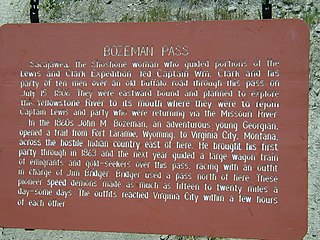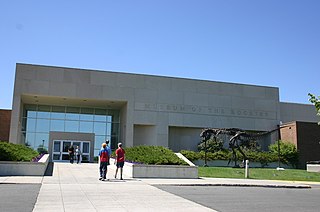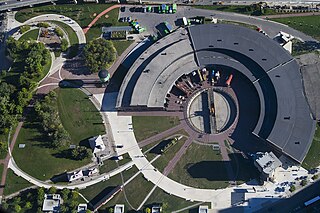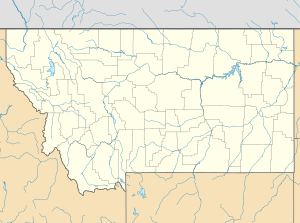
The Denver & Rio Grande Western Railroad, often shortened to Rio Grande, D&RG or D&RGW, formerly the Denver & Rio Grande Railroad, was an American Class I railroad company. The railroad started as a 3 ft narrow-gauge line running south from Denver, Colorado, in 1870. It served mainly as a transcontinental bridge line between Denver, and Salt Lake City, Utah. The Rio Grande was also a major origin of coal and mineral traffic.

Bozeman is a city and the county seat of Gallatin County, Montana, United States. Located in southwest Montana, the 2020 census put Bozeman's population at 53,293, making it the fourth-largest city in Montana. It is the principal city of the Bozeman, MT Micropolitan Statistical Area, consisting of all of Gallatin County with a population of 118,960. Due to the fast growth rate Bozeman is expected to be upgraded to Montana's fourth metropolitan area. It is the largest micropolitan statistical area in Montana, the fastest growing micropolitan statistical area in the United States in 2018, 2019 and 2020, as well as the third-largest of all Montana's statistical areas.

The Great Northern Railway was an American Class I railroad. Running from Saint Paul, Minnesota, to Seattle, Washington, it was the creation of 19th-century railroad entrepreneur James J. Hill and was developed from the Saint Paul & Pacific Railroad. The Great Northern's route was the northernmost transcontinental railroad route in the U.S.

The Chicago, Milwaukee, St. Paul and Pacific Railroad (CMStP&P), often referred to as the "Milwaukee Road", was a Class I railroad that operated in the Midwest and Northwest of the United States from 1847 until 1986.

The Minnesota Transportation Museum is a transportation museum in Saint Paul, Minnesota, United States.

The North Coast Limited was a named passenger train operated by the Northern Pacific Railway between Chicago and Seattle via Bismarck, North Dakota. It started on April 29, 1900, and continued as a Burlington Northern Railroad train after the merger on March 2, 1970 with Great Northern Railway and the Chicago, Burlington and Quincy Railroad. The next year, it ceased operations after the trains which left their originating stations on April 30, 1971, the day before Amtrak began service, arrived at their destinations.

Bozeman Pass el. 5,702 feet (1,738 m) is a mountain pass situated approximately 13 miles (21 km) east of Bozeman, Montana and approximately 15 miles (24 km) west of Livingston, Montana on Interstate 90. It separates the Bridger and Gallatin mountain ranges.

Montana Rail Link is a privately held Class II railroad in the United States. It operates on trackage originally built by the Northern Pacific Railway and leased from its successor BNSF. MRL is a unit of The Washington Companies and is headquartered in Missoula, Montana.

Museum of the Rockies is a museum in Bozeman, Montana. Originally affiliated with Montana State University in Bozeman, and now also, the Smithsonian Institution, the museum is known for its paleontological collections, although these are not its sole focus. The Museum of the Rockies houses the largest collection of dinosaur remains in the United States, possessing the largest Tyrannosaurus skull ever discovered, as well as the thigh bone of a Tyrannosaurus rex that contains soft-tissue remains. The museum is part of the Montana Dinosaur Trail and is Montana's official repository for paleontological specimens.

Spokane, Portland & Seattle 700 is the oldest and only surviving example of the class "E-1" 4-8-4 "Northern" type steam locomotive and the only surviving original Spokane, Portland and Seattle steam locomotive. It was built by the Baldwin Locomotive Works in May 1938. Nearly identical to the class "A-3" Northerns built for Northern Pacific Railway, it burns oil instead of coal.

Fort Ellis was a United States Army fort established August 27, 1867, east of present-day Bozeman, Montana. Troops from the fort participated in many major campaigns of the Indian Wars. The fort was closed on August 2, 1886.

Roundhouse Park is a 17 acre park in the downtown core of Toronto, Ontario, Canada. It is in the former Railway Lands. It features the John Street Roundhouse, a preserved locomotive roundhouse which is home to the Toronto Railway Museum, Steam Whistle Brewing, and the restaurant and entertainment complex The Rec Room. The park is also home to a collection of trains, the former Canadian Pacific Railway Don Station, and the Roundhouse Park Miniature Railway. The park is bounded by Bremner Boulevard, Lower Simcoe Street, Lake Shore Boulevard West/Gardiner Expressway and Rees Street.

Fred Fielding Willson, most commonly known as Fred F. Willson, was an architect in Bozeman, Montana who designed many buildings that are listed on the National Register of Historic Places.

Albert, Alfred, and Alfred "Chris" Schlechten were members of a family noted for their photography of Montana, especially their images of Gallatin County, Montana, and Yellowstone National Park. Headquartered in Bozeman, Montana, brothers Alfred and Albert started a family photography business in 1900, and the business continued until the death of Alfred's son Chris Schlechten in the late 1970s. The heirs of the Schlechten family sold an extensive collection of the photographs taken by the three men to the Museum of the Rockies in 1980.
This is a Timeline of pre-statehood Montana history comprising substantial events in the history of the area that would become the State of Montana prior to November 8, 1889. This area existed as Montana Territory from May 28, 1864, until November 8, 1889, when it was admitted to the Union as the State of Montana.

Transportation in Montana comprises many different forms of travel. Montana shares a long border with Canada, hence international crossings are prevalent in the northern section of the state; there are 13 road crossings and one rail crossing.

Merrill G. Burlingame was a history professor at Montana State University in Bozeman, Montana who specialized in Montana history and the history of the American West. He was instrumental in the founding of the Museum of the Rockies and driving force behind the resurgence of the Montana Historical Society in the 1960s. In his time, he was known as "Mr. Montana History."


















